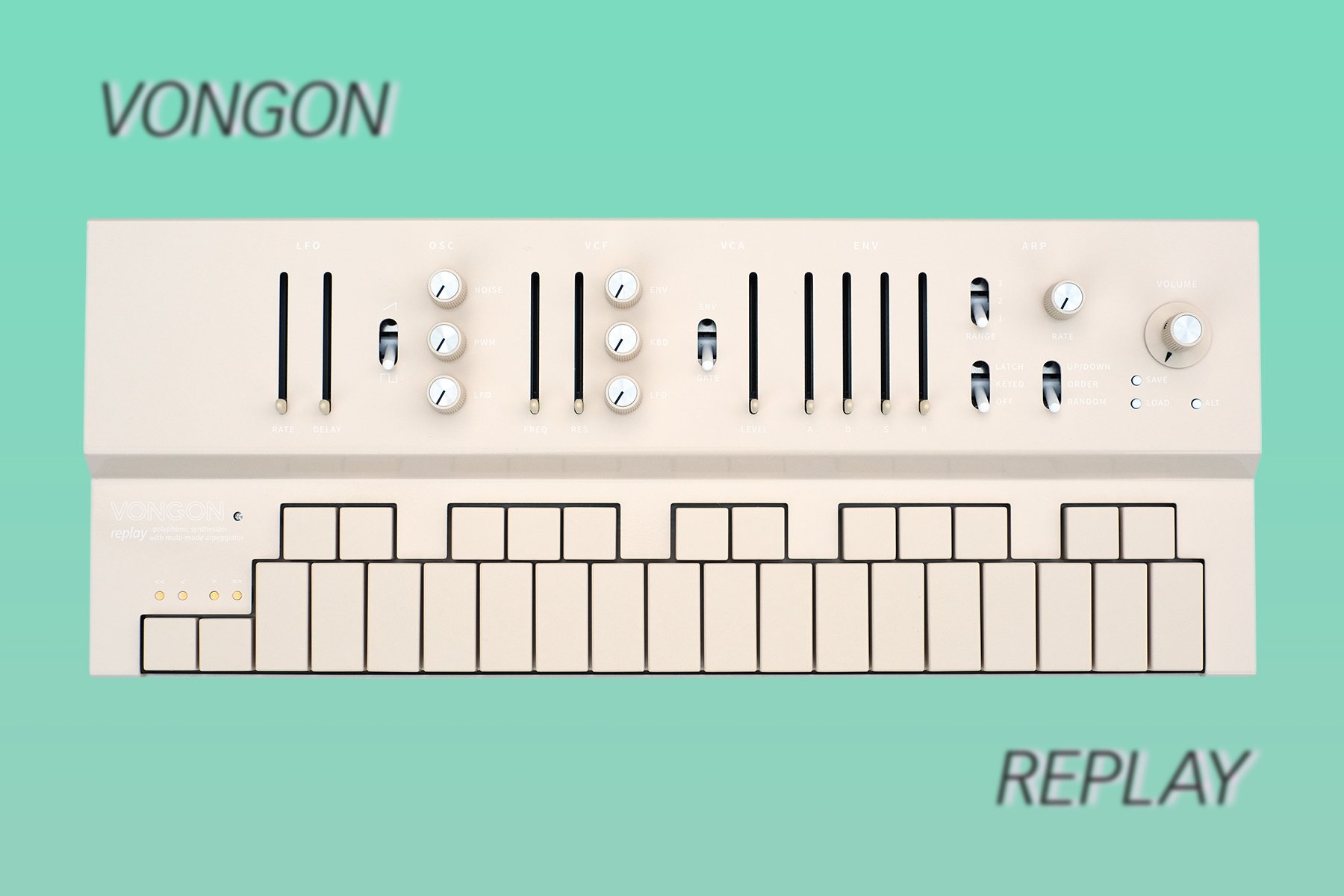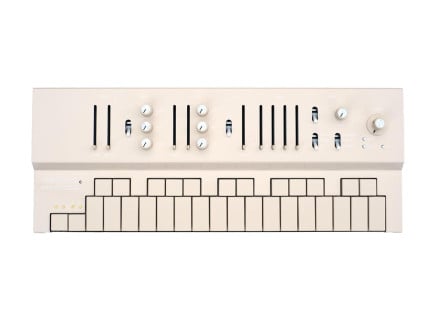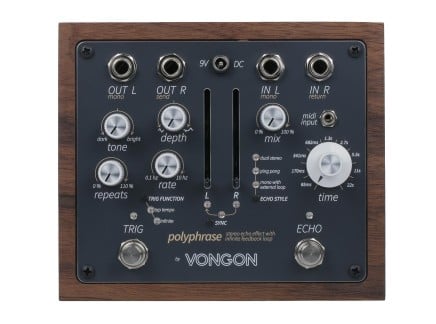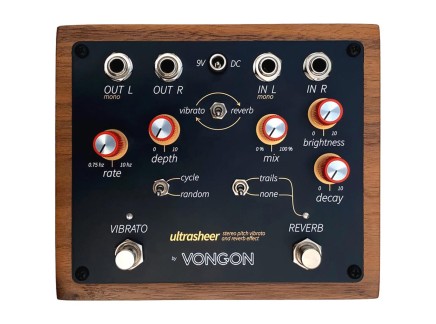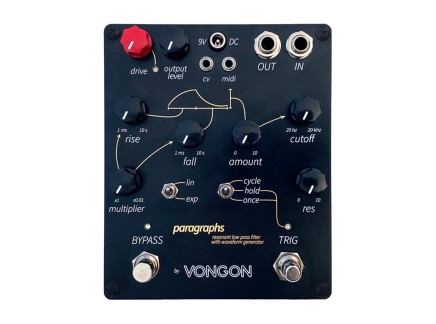The last few years, VONGON has emerged as one of the pre-eminent makers of boutique effect pedals. Based in Oakland, California, VONGON produces small runs of high-quality effects, including the now-legendary Paragraphs filter pedal, the Ultrasheer stereo reverb/vibrato, and of course, the Polyphrase—a stereo delay/looper perfect for exploring all manner of sonic spaces.
Because they've become so well-regarded specifically in the sphere of effect pedals, today's new might come as a shock: they've just announced the availability of the replay, a compact virtual analog synthesizer. Like their past releases, replay is pure class: it's a six-voice polyphonic synthesizer sporting a classic analog-style signal flow. Housed in a compact powder-coated metal chassis and sporting Cherry MX tactile switches for keys, it looks as beautiful as it sounds. And indeed, it sounds great—we expect it'll be quite at home with all of you ambient shoe-gazing synth players, guitarists in need of an easy-to-use and great-sounding side synth, or sound designers looking for a highly refined and immediate tool for exploring the tones and techniques of classic analog synthesizers.
Of course, replay isn't just about exploring the sounds of the past: it's a testament to how intentional user interface design can guide your interactions, leading you to results that another similarly-specced instrument might struggle to achieve. We've spent a fair amount of time playing replay, and despite using a sound design architecture similar to many familiar synthesizers (like a Roland Juno or Korg Polysix), it does feel like it has its own character and its own idiomatic playing styles—which, happily, we're still discovering to this day.
So, in our mind, VONGON's first official step into the world of synthesizer design is a success: they've presented the world with an all-new instrument that maintains its own identity when viewed alongside other conceptually similar instruments—and that's no small task. To better understand where replay came from and how it works, we reached out to Ryan McGill, the founder of VONGON and designer of replay's synth engine. The following interview is what he had to say.
An Interview with VONGON
Perfect Circuit: Thanks so much for taking some time to answer a few questions as we introduce the Replay to our corner of the synth world. Before we jump into talking about the instrument itself, I’m curious to know more about the person behind all your wonderful audio devices—both about you and the music you create. How did you get started in music making, and what ultimately led you toward creating your own devices?
VONGON: Thank you for the opportunity to share a bit about myself and my journey into the world of music and electronics. My formal background lies primarily in electrical engineering, but my love for music and sound has always been the driving force behind our products.
As a young child I was immediately drawn to a circuit board exhibit at a science museum. There was a patch bay on display—and I absolutely loved plugging in the cables, seeing the lights blink and watching the connections I made come to life. I have always really enjoyed seeing how things work and learning how to create something new.
I began guitar and playing in bands around the age of thirteen, but what I really loved was writing and recording music. In my early twenties, I had an opportunity to work in a professional recording studio; I became instantly obsessed with the art of creating and capturing sound. I distinctly recall the moment when I first heard a compressor smashing a drum set—I couldn’t believe what I was hearing! The sounds were amazing and truly motivated me to learn more about electronics and their potential to shape and manipulate sound. While music remained my passion, I received my EE degree and pursued a career in engineering.
I was wrapping up a contract for a software startup in San Francisco, January 2020, when I had a unique opportunity and decided to dedicate all of my energy into designing and building audio hardware—which became VONGON. Shortly after, the global pandemic hit and presented me with many unforeseen challenges, making product manufacturing far more difficult than I had anticipated. With much patience, persistence, and a lot of hard work, I was able to get some traction going. A year later, my fiancé left her design job to join VONGON, and we are loving it!
Having our small team of two has many benefits and our ability to work so well together allows our business to thrive, connection to grow and commitment to flourish. We are getting married this April (4.4.2024) and can’t wait to see where VONGON will take us next!
PC: Aside from the expressive sounds they can create, Vongon devices are known for their clear interfaces and stunning design. To what extent are aesthetics important to you in a piece of gear, and how have you tried to capture that for the Vongon devices?
VG: I love to use a piece of gear that feels intuitive. During the design process, we look for the balance between quantity of features and clarity of the user interface. Vintage gear is a huge part of our inspiration—both sonically and aesthetically. The way our products sound and look are equally important to us. As the company has grown our aesthetic has also grown and taken form. Number one is obviously sound, but making sure that the sound comes from a beautiful instrument that functions with simplicity is the goal.
PC: From the warm cream-colored exterior to the tactile mechanical keys, the replay itself is no exception to your knack for creating beautiful and eye-catching pieces of gear. Were there specific inspiration points for the replay's aesthetic?
VG: My fiancé, Katie, took the lead on designing replay. Her background in design has greatly helped the company and pushes us to the next level. (She is not only our designer, but our solderer and pedal assembler as well.) From the shape of the keybed, sleekness of the enclosure, custom finishes, and even the functionality of replay as both an instrument, and as an art piece—she was adamant that we not compromise the design of this product. We spent so much time working on each and every detail of replay, and think it looks, feels and of course sounds, exactly as planned—rad!
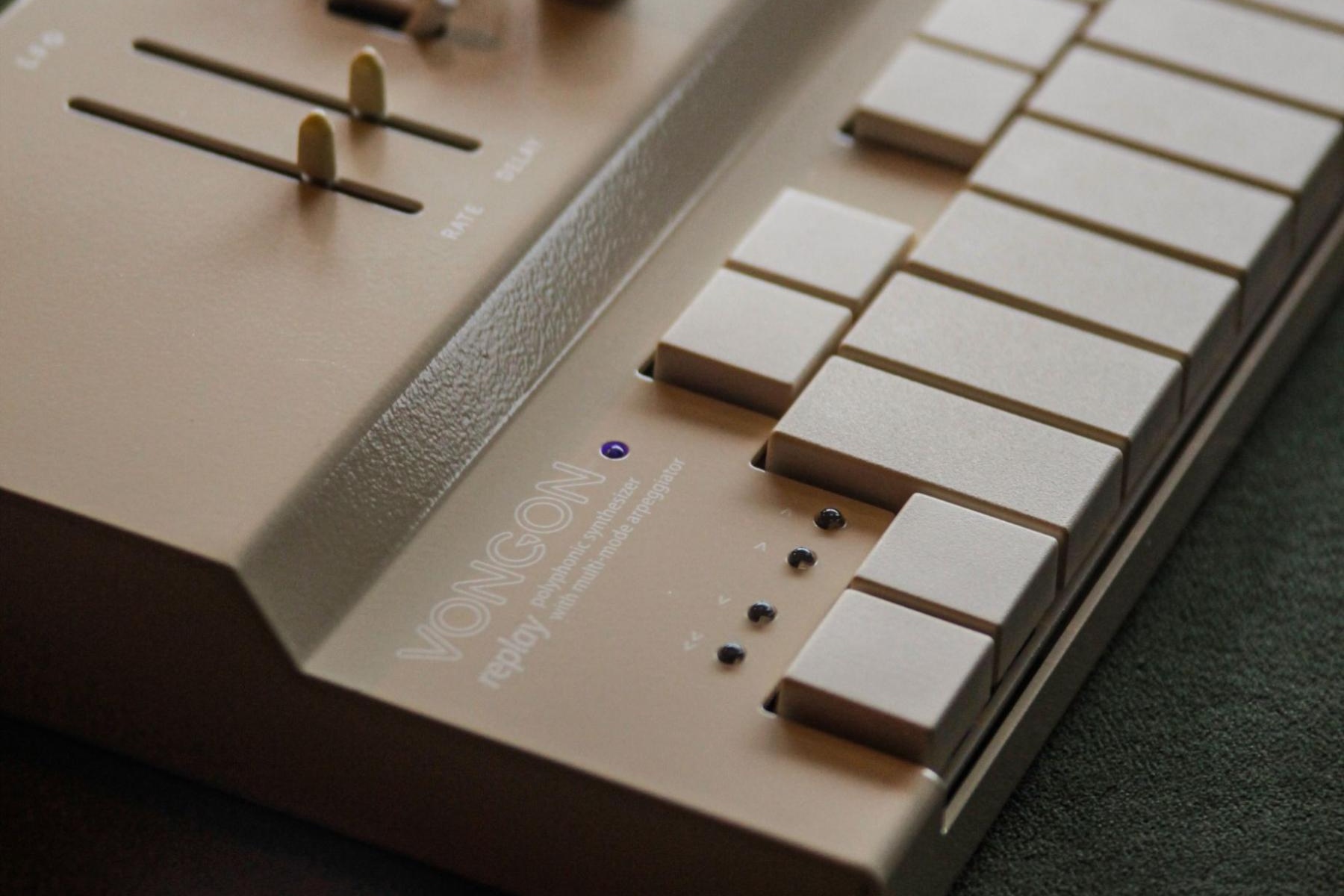
PC: With your history making Moogerfooger MF-104m controllers, the subtle kinship of the Moog MF-101 to your Paragraphs pedal, and the clear popularity both Vongon stereo pedals have with synthesizer players, a Vongon synthesizer seems like an obvious fit—though I’ll admit I can’t say I saw it coming. What brought you to designing the first Vongon synthesizer with replay?
VG: I’ve been wanting to make a synthesizer for so long, and similar to effects pedals, there are a ton of variations and directions you can go. For our first synthesizer, we focused on sounds that feel “classic.” The early era of polyphonic synthesizers like the Roland Juno, Korg Polysix, and Sequential Prophet 5, all have such a distinct sound due to the technical limitations of the time.
For example, you only get one or two oscillators per voice, a single LFO, and just a handful of polyphony. The idea of replay is to bring you back to those sounds, but boldly lean on modern technology to provide an ideal version of those sounds. This translates to a super smooth, high-definition sound that still has the spirit of those classic instruments.
PC: Across the Ultrasheer, Polyphrase, and Paragraphs, and now in the replay, we can see a clear inspiration from vintage synthesizers and effect units, specifically from the late 70s and early 80s. While obviously a well-loved time period for audio tools, what is it about this specific period of audio history that continues to inspire you in creating freshly reimagined tools for the modern era?
VG: I particularly enjoy audio tools from that time period because digital technology was just being introduced and used in combination with existing analog designs—creating some truly exciting instruments and processors. The software and hardware schematic designs are so clever, especially considering the limitations that the designers had to work around—such as slow digital processing speeds, noisy analog components, limited memory, etc. I enjoy evaluating these designs and putting my own spin on the product because I have the luxury of modern technology. In short, I greatly appreciate these iconic products that heavily inspire our own.
PC: Many synthesizer players have a virtual analog synth they hold dear, usually being straightforward, compact, and character-rich synths—much like the replay. Considering we’ve seen both fantastic analog and digital circuits from Vongon, what brought you to making a virtual analog synth in particular?
VG: replay is designed with the Roland Juno 106 and Korg Polysix in mind, specifically. It is not a clone, but rather my own compact version of an instrument that covers the sounds I love from those synths. Initially, I prototyped the design as an analog circuit, with oscillators that were clocked from a digital microprocessor, mirroring the original Juno operation. However, that analog design turned out to be a bit of a nightmare for us. I totally underestimated the difficulty of maintaining consistency between each voice (ie. filter tuning, resonance, envelope response, volume balance, etc.) Ultimately, I had to make a tough decision and discard about eight months of work. I started over and recreated the design in software as a virtual analog system.
The digital design came together surprisingly quickly for me, and sounded even better! I gained significantly more granular control over the factors that were challenging in the analog design. The filters harmonized better, the envelopes were much snappier, and I could fine-tune the response curves of each control. A typical challenge when designing a digital instrument is to maintain the warmth and character of the analog equivalent, but because I was so familiar with the analog circuit, I was able to really fine-tune the tones of replay.
In the end, the eight months of analog work weren’t a complete loss. The discarded work helped me grow and expand what I thought was possible. We are extremely pleased with the way everything turned out.
PC: The replay's multi-mode arpeggiator was a defining characteristic for me, with tricks like clocking the LFO in time with the ARP leading to some of my favorite moments with the instrument. Have arpeggiators been an important aspect of your work with synths, and what considerations went into the design we find on the finished instrument?
VG: I don’t have a ton of experience with arpeggiators, but I chose to add one to replay because they are a lot of fun (Katie’s Favorite Feature!).
The instantaneous, programmable melodies are easily accessible without the complications of a full-blown sequencer. There is quite a bit of thought and functionality in the replay arpeggiator that may not be obvious at first glance. The “latch” behavior changes based on the poly mode of the synth. In poly mode one, it will create an ever-increasing stack of notes to be played each time you press a new key. In the poly mode two, it will clear itself on every chord change to make it easy to maintain an arpeggiated chord progression. Additionally, the “latch,” mode can be used like a hold function. When setting the envelope attack and release times to be longer, you can keep a chord playing that feels more dynamic than a static chord from a traditional hold function. The arpeggiator also beat syncs to MIDI clock and can be used as a live quantizer with a Digital Audio Workstation (DAW), drum machine, or sequencer.
PC: Both the replay and Paragraphs feature 4-pole low pass filters, though the Paragraphs is all-analog, while the replay utilizes digital circuits. I found the filter on the replay to be very warm and responsive, helping to define the instrument's overall character—as filters often do! Having had so much experience with analog filters, for instance with the AS3320 chips in the Paragraphs, what sort of considerations led you to the virtual analog filter design we hear in the replay?
VG: I love the sound of the AS3320 filter that we use in Paragraphs, and I knew that I wanted a similar sound for the replay. I started the filter design with an algorithm intended to emulate a Moog Ladder filter. I made the necessary adjustments to make the filter resonate into self-oscillation in a way that sounded best to me. As you increase the resonance, you will hear some low-end reduction, as often found on resonant low-pass filters. I find that to be a hidden, but useful, high-pass filter—this can help clean up muddy chords.
The filter resonates into a perfect sine wave that can be used as a second harmonizing oscillator on the replay. When you set the KBD knob all the way up, the filter frequency follows the oscillator frequency, and you can use the filter frequency slider to dial in a harmony or detuned unison sound. That is where some of my very favorite sounds on replay come from.
PC: The replay is a joyful instrument on its own, but I found the addition of an Ultrasheer and Polyphrase incredibly fun to explore, getting lost in dreamy ambiences and swirly arpeggios. How have you enjoyed using the replay—either with other gear or not—and where do you think it excels as part of a larger musical practice?
VG: I wanted replay to mesh seamlessly with any effect pedal; so much so, that I designed the power supply to work with the standard 9-volt center-negative power supply that you see on 99.9% of guitarists' pedal boards. I highly encourage users to play replay with their effect pedals, and really experiment. Modulation and spatial effects (like Ultrasheer and Polyphrase) work really well for ambient style and early 80s polysynth sounds. Dirt and drive pedals help replay sit in a mix of guitars.
This portable synth is such a nice fit for traveling, easy set-up for rehearsal, and of course for big performances. There are endless possibilities—whether at home or on tour. Lately, we’ve been having a lot of fun using replay with our Teenage Engineering OB-4 speaker. The bass sounds killer, and the ambience mode works great with replay.
PC: As a digital instrument, the Replay is potentially upgradable via firmware updates. Are there any major plans for adding functionality to the Replay down the line?
VG: Yes! The replay WEB Interface was designed to enable additional features and firmware updates. This is the first VONGON software product—intended to support and expand the functionality of the hardware. My dear friend, Matt Oliver, truly helped make this happen. The replay WEB Interface adds virtual knobs that can live inside hardware presets.
I knew that the hardware interface would quickly become too confusing if we added too many features that didn’t map to a specific hardware parameter. For example, I knew we wanted to offer at least seven different waveform options on the LFO, but there is no seven-position toggle switch. The replay WEB Interface is a unique tool that lets the user see each parameter in a single view. When you’ve created a sound that you like, you can save it as a preset to enable quick access with just the hardware in front of you. It also helps with configuration settings like MIDI adapter type and MIDI channel. When you have your favorite sound dialed in, you can save that as a preset into a JSON file, allowing you to build your own preset library or create a bank of sounds that can be shared with other replay users.
We definitely plan to release updates and add more features down the line. I won’t be too specific on these plans because we only like to add features that we have fully tested and are ready to include. We are always open to our customers' suggestions and we welcome direct emails through our website’s contact page.
PC: Having expanded beyond pedals alone, it's interesting to imagine what other sorts of products we might see from Vongon in the future. So, what is next for Vongon? Will we see another synthesizer sometime in the future? Are there other sorts of audio tools you’re interested in developing?
VG: We are totally jazzed that replay has brought VONGON beyond effect pedals—and there is certainly more on the horizon. Designing a new product feels similar to recording an album—once completed, we are ready to take what we’ve learned and make a million more! We have a lot of great designs currently in development, but that’s all we’ll say for now. Stay tuned!

